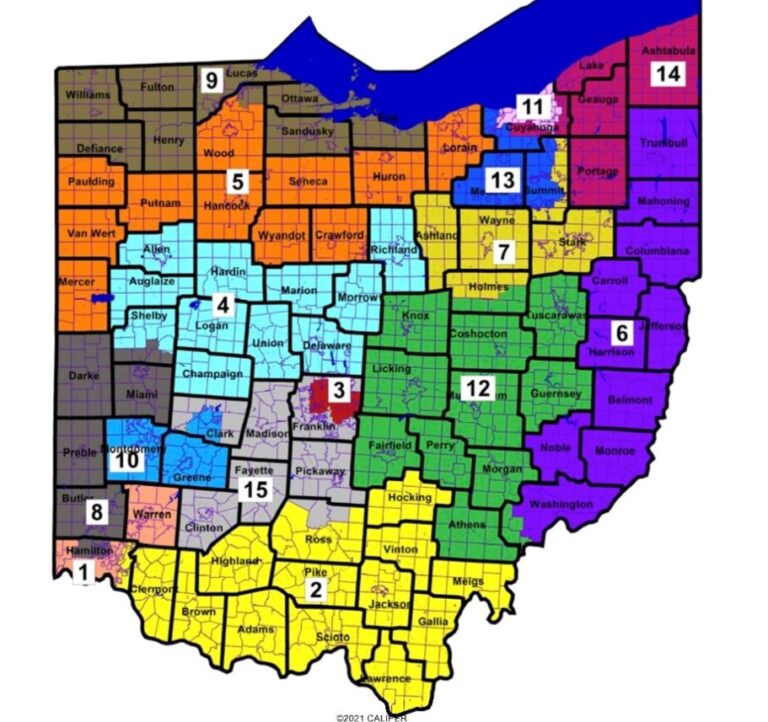BY SUSAN TEBBEN
In a 4-3 decision, the Ohio Supreme Court struck down the state’s new U.S. Congressional map on Friday, saying three counties in particular were “unduly split” by the Ohio General Assembly.
“We hold that the congressional-district plan is invalid in its entirety because it unduly favors the Republican Party and disfavors the Democratic Party in violation of the (Ohio Constitution),” Justice Michael Donnelly wrote for the majority opinion.
The four justices who invalidated the map – Justice Donnelly, Chief Justice Maureen O’Connor, Justice Jennifer Brunner and Justice Melody Stewart – said specifically that Hamilton, Cuyahoga and Summit counties were unduly split in violation of the section of the constitution that prohibits the General Assembly from creating a map that favors or disfavors one political party.
“The enacted plan splits Hamilton County into three districts for no apparent reason other than to confer an undue partisan advantage on the Republican Party,” the majority wrote, adding later that Summit and Cuyahoga counties were also split for the same reason, based on the evidence.
The maps were challenged by the National Redistricting Action Fund on behalf of private Ohio citizens, along with the League of Women Voters of Ohio in a separate lawsuit. Both lawsuits accused the legislature, specifically legislative leaders Senate President Matt Huffman and House Speaker Bob Cupp, of passing maps that unfairly represented Ohio voters in the state.
In siding with the challengers, the state’s highest court said the constitution not only explicitly regulates the process of redistricting, but “expressly forbids partisan gerrymandering.”
“When the dealer stacks the deck in advance, the house usually wins,” according to the majority opinion. “That perhaps explains how a party that generally musters no more than 55% of the statewide popular vote is positioned to reliably win anywhere from 75% to 80% of the seats in the Ohio congressional delegation.”
Chief Justice O’Connor, once again seen as a swing vote in the case as she was in the legislative redistricting lawsuits, said the legislative leaders who worked to pass the maps used the “illusion” of a competitiveness standard, rather than considering other constitutional requirements, and asked voters to “be satisfied by a ‘coin toss’ without acknowledging the significant partisan advantage created across the state.”
“No magician’s trick can hide what the evidence overwhelmingly demonstrates: the map statistically presents such a partisan advantage that it unduly favors the Republican Party,” O’Connor wrote in her separate but still concurring opinion.
The evidence proved that the plan approved by the General Assembly favored the Republican Party and disfavored the Democrats “to a degree far exceeding what is warranted” by the constitution, the majority stated.
That evidence, which included several political scientists who studied election results and various ways of calculating district lines in the state, “significantly outweighs” the evidence provided by legislative leaders “as to both sufficiency and credibility,” according to the ruling.
Expert analysis showed that not only did the congressional map fail to follow the constitution’s “neutral districting criteria” statewide, but specifically in Ohio’s largest metropolitan areas, neutral criteria or Ohio’s political geography wasn’t considered.
Instead, the inescapable conclusion is that they are the product of an effort to pack and crack Democratic voters, which results in more safe Republican districts or competitive districts favoring the Republican Party’s candidates.
An argument made by Huffman and Cupp that they attempted to make competitive districts where possible in lieu of other map considerations was rejected by the court because competitiveness is not a requirement in the constitution.
“But it does require the General Assembly to attempt to draw districts that are compact,” the majority stated in its ruling.
The justices who dissented to the decision were the same dissenters to a majority opinion striking down the legislative maps released earlier this week. Justices Sharon Kennedy, Patrick Fischer and Patrick DeWine joined in a scathing dissent that said the majority rejected the congressional maps “without presenting any workable standard about what it means to unduly favor a political party or divide a county.”
“So what the majority is essentially saying is: we don’t like the legislature’s choices of counties to divide; it should have divided different ones,” the dissenting justices wrote. “But that’s a matter of policy preference – it has nothing to do with the law.”
The three dissenting justices used one of the same arguments they used in the dissent of the rejected legislative maps: The Ohio Supreme Court is limited by the constitution in their authority to demand changes, and shouldn’t use policy over legal precedent and plain language.
“Because the majority strays well beyond both, we respectfully dissent,” they wrote.
Justice DeWine, son of the Ohio governor and Ohio Redistricting Commission member Mike DeWine, declined to recuse himself from the case.
The General Assembly now has 30 days to come up with a new map following the constitutional regulations. This is on top of the 10-day clock that has started on the legislative redistricting maps as of Wednesday.
The map has to “remedy any legal defects” in the previously approved plan, but no other changes can be made, according to the ruling. If a new congressional plan isn’t passed in that time, the Ohio Redistricting Commission will be reconvened and have 30 days to pass a new map.





